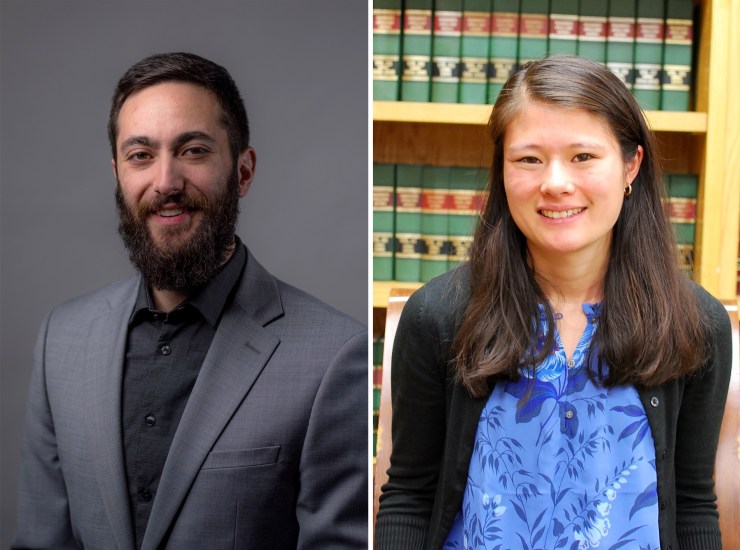The untold stories of 123 Black people killed by white police officers in one Alabama county

The police killings of George Floyd and Breonna Taylor are recent examples of a tragic narrative that is sewn deep into American history, as affirmed by a new report from Northeastern’s Civil Rights and Restorative Justice Project that uncovers a terrifying span of violence by law enforcement in Alabama.
The investigation finds that 123 Black people were killed by white police officers from 1932 to 1968 in Jefferson County, which serves Birmingham, Alabama’s largest city.

Left, Alex Stein. Right, Katie Sandson. Courtesy photos.
The researchers discovered that in only 24 of these cases, victims had been stopped originally for carrying a weapon or making a threat. In 51 of the killings, the victims had no weapon of any kind; in most of these cases, they were found to have been shot in the back while running away from police.
In only two cases were officers put on trial for the killings, the investigation finds. Neither resulted in a guilty verdict.
Twenty police officers were involved in multiple killings without apparent consequence, including James Albert Hale Jr., a patrolman who was responsible for the deaths of five Black men in a span of eight years. In 1951—one year after his spree ended—the Birmingham Police Department promoted Hale to detective.
“If this was the case in one police department—and we didn’t know about it until we happened to come across these files—then what are the numbers in other police departments across the country that we don’t know about?” says Katie Sandson, a legal fellow at the justice project who led the investigation. “Without knowing and acknowledging these histories, how can there ever be trust in these systems today? Our report illustrates how this wasn’t just a police failure. It was a legal system failure.”
The report accounts for 127 deaths in all by police officers over the four decades, including four victims who were white. Of the 123 Black victims, 121 were men.
Over a span of 26 years between 1936 and 1963, the commissioner of public safety in Birmingham, where most of the police killings took place, was Eugene (Bull) Connor, who infamously turned fire hoses and attack dogs on civil rights protesters, including children, in 1963.
In 1948, Connor led the political convention of the newly-formed Dixiecrat Party in Birmingham. The Dixiecrats objected to equality reforms that were being proposed by Democrats, including anti-lynching laws, elimination of the poll tax (which prevented Black people from voting), and the integration of the U.S. military. The Northeastern researchers found that the killings in Jefferson County peaked around the time of Connor’s political stand, with 16 Black men killed by police in 1948.
“Most Americans know of Bull Connor’s brutality from the photographs of police dogs chasing Black kids in the streets of Birmingham in 1963,” says Margaret Burnham, director of the Civil Rights and Restorative Justice Project. “But he had an equally violent past. This report brings that to life.”
The justice project was founded a decade ago by Burnham, a lifelong civil rights activist and university distinguished professor of law at Northeastern, to investigate acts of racial injustice that took place in the Jim Crow South from 1930 to 1970. Northeastern law students have driven the efforts to uncover and catalog the stories of about 500 victims, with another 1,000 still to be investigated.
In 2018, Alex Stein, a Northeastern law student enrolled in the justice project, discovered that a Birmingham police officer, Jesse Lambert, had been involved in the killings of four Black men. On a subsequent trip to Birmingham, Stein discovered internal police files that revealed more Black victims at the hands of law enforcement.
Stein’s work was renewed last fall by the project. Sandson and a dozen staff and students pored over newspaper archives, internal police records, coroners’ reports, and other documents while expanding upon Stein’s works.
The five known victims of patrolman James Albert Hale included:
- Knox Fail, who was approximately 40 years old when he was killed in a shootout with police in 1943.
- Harrison Lee, a 39-year-old owner of a barbershop, who was killed in a 1946 shootout with Hale and his partner.
- John Johnson, who in 1948 was shot and killed by Hale and his partner in an alley behind a dry goods store. No explanation was given for why the police had stopped Johnson, a 42-year-old father of nine children.
- Theris Rudolph Wood, a 19-year-old who in 1948 was fleeing the backyard of a white family’s home when he was killed by a gunshot to the back of the head as Hale and his partners fired.
- Eugene Burt, a 46-year-old butler, who in 1950 was shot and killed in his home. There were no witnesses other than Hale.
All five deaths were ruled as justifiable homicides by the Jefferson County coroner. Ten years after Hale was promoted to detective, he was elevated again, in 1961, to the rank of sergeant.
“It’s emblematic of several other career paths of officers that we found,” Sandson says. “When officers are getting promoted into supervisory positions, they are continuing to influence the culture of the department—and in some cases they also become the investigators of these incidents.”
At a 2017 symposium hosted by the Civil Rights and Restorative Justice Project in Birmingham, A.C. Roper, the police chief in Birmingham at that time, issued a formal apology for the acts of racial violence that had been committed by the department.
Last March, before the full extent of the police killings in Jefferson County was known, the project held another event in Birmingham that was limited by the COVID-19 pandemic. Researchers have been communicating with surviving family members in order to explore the victims’ stories. Sandson hopes that other organizations and activists will build upon the Northeastern researchers’ work in Birmingham and in other cities.
The recent deaths of Floyd, Taylor, and other Black people affirm the urgent need for an historical reckoning of police killings, Sandson says.
“What else don’t we know? How can there be repair and trust in law enforcement today until we know the full extent of what has happened?” Sandson says. “What we are seeing today underscores the importance of building out the archive, as well as the need for others to engage in this work across the country with the support of local governments.
“Projects like this provide the information that is needed to have a full accounting so that we can start to grapple with history today.”
For media inquiries, please contact media@northeastern.edu.






